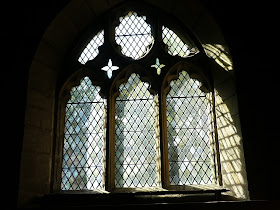A record of wildlife in my garden and various trips to the Warwickshire countryside and occasionally further afield.
Thursday, 19 September 2019
St Peter's Church - Market Bosworth
As mentioned in the previous post I had a quick look around the church at Market Bosworth while B and E went to explore the country park.
Construction of the tower, nave and north aisle of St Peter's began in the 1300's replacing an earlier church mentioned in the Domesday book of 1086. The south aisle was added in the late 1300's. The tower houses eight bells dating from around 1580.
I only saw the churchyard around the path to the entrance but it did seem rather "manicured" although there were plenty of trees.
Plain glass windows can look very beautiful when the sun shines through them.
The stump base of the font may date from the earlier church. The 14th century hexagonal top of the font retains traces of original colour on the shields.
The squint or hagioscope would have allowed a priest inside the chapel to see the Elevation of the Host at the main altar during communion. Sometimes he would ring a sanctus bell at this stage of the service.
19th century stone angel carving.
These banners commemorate the 500th Anniversary of the Battle of Bosworth on 22nd August 1485.
Half hidden behind an ancient oak chest is the coat of arms of the Dixie family showing the snow leopard. Unfortunately I didn't take a photo of the medieval chest which contains a signature on the top of a child who later became a church warden. The signature dates from 1618.
The pulpit was installed in 1895 and contained four carved figures of which two are now missing.
The oak rood screen dates from 1895.
There were two beautiful carved owls but it was so dark that I just couldn't get a decent photo.
Tomb of John Dixie who was rector 1685 - 1719. The "weeping lady" is his sister Margaret.
The East window is by Charles Kempe.
Statues of St Paul and St Peter
It was an interesting church and I am glad I had the chance to look round.
All photos taken by me with the Panasonic Lumix FZ330 bridge camera
Reference: Leaflet to St Peter's Church
























































I am always fascinated by how, despite being restricted by style conventions, the mix of styles over the centuries yields so much diversity from church to church. They may all share similarities, yet each is unique to it's own individuality. Hopefully the well manicured church yard is compensated for by all those lovely trees?
ReplyDeleteRustic Pumpkin - Thanks so much. You are spot on about the diversity - everyone is different from pulpits to fonts to roofs to stained glass etc. I just love the sense of past, the history, the architecture and the sense of peace you get in churches.
ReplyDeleteThe churchyard may have had wilder areas - not sure as I didn't explore churchyard too much as had run out of time! I don't know a lot about Britain in Bloom but I suspect it may mean having a very tidy town so perhaps that has something to do with it?? Just surmising here :)
It looks a very elegant church both inside and out. It's a shame about the 'just mown' look of the grass around the graves, perhaps there are wilder corners beyond the trees. The windows are lovely and the font unusual. The rood screen looks very elegant too. I wonder what happened to the two missing carved figures from the pulpit? Theft or damage perhaps.
ReplyDeleteYou asked on my blog where the 'Sea Shanty' was situated. It was at Trearddur Bay not far from South Stack:)
Rosie - Thanks so much and yes perhaps there are wilder areas beyond the trees and behind the church.
ReplyDeleteIt would be interesting to know what happened to the missing pulpit figures - there is no more info in the guide book.
Thanks so much for letting me know where the Sea Shanty is. Something to remember for our next visit. We did detour briefly on leaving South Stack as I wanted to see what Trearddur Bay looked like on our way back to Penmon but I missed the Sea Shanty.